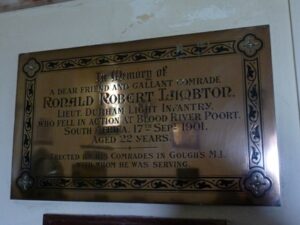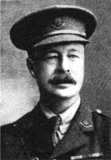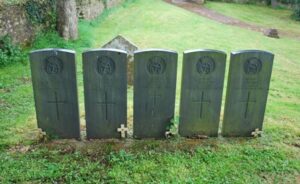Castlemartin lies about six miles from Pembroke, its parish forming a promontory on the sea coast, which is bounded on the north by Freshwater West, which runs into St. George’s channel, on the east by the adjoining parish of Warren, and on the west and south by the Bristol channel. Much of the local land is take up by the MOD Firing Range, which covers around 2,400 hectares. The village is sited around a Norman Motte and Bailey castle, and the church, once dedicated to St. Martin, but nowadays to St. Michael, gave the village its name. There are several war graves and memorials locally, within the St. Michaels Church and at Flimston Chapel, which commemorate the local men who have died in military service, ranging from the Boer War to World War Two and later.

The Boer War, 1899-1902
Alexander Frederick Lambton, Captain, Highland Light Infantry. Alexander was born in January 1869, the son of Lieutenant-Colonel Francis William Lambton, of Brownslade, Pembrokeshire, late Scots Guards, and Lady Victoria Alexandrina Elizabeth, eldest daughter of John Frederick Campbell, second Earl of Cawdor. He was educated at Wellington, and then at the Royal Military College. Alexander was gazetted into the 1st Battalion, Highland Light Infantry during August 1888, being promoted Lieutenant in May 1890, and Captain by May 1896. He took part in the occupation of Crete in 1898, for which he was mentioned in despatches. Alexander embarked for South Africa in October 1899, with his battalion, and joined the Kimberley Relief Force under Lieutenant General Lord Methuen shortly before the battle of Magersfontein. Alexander was killed in action at Magersfontein on 11 December 1899. He was 30 years old, and is buried at Kimberley, West End Cemetery.


Ronald Robert Lambton, Lieutenant, Durham Light Infantry. Ronald was born in March 1879, the son of Lieutenant-Colonel Francis William Lambton, of Brownslade, Pembrokeshire, late Scots Guards, and Lady Victoria Alexandrina Elizabeth, eldest daughter of John Frederick Campbell, second Earl of Cawdor. He was educated at Wellington, prior to being commissioned into the 3rd Battalion, Duke of Cambridge’s Own Middlesex Regiment. Ronald transferred to the 1st Battalion, Durham Light Infantry in May 1899, and was promoted Lieutenant in November 1900. He went to South Africa with his battalion in October 1899, which formed part of the Natal Field Force, was present at the battle of Colenso, and in the operations on the Tugela from 12 January until 6 February 1900, being severely wounded in the engagement at Vaal Kranz. He also took part in the advance through Northern Natal into the Transvaal. Ronald was mentioned in despatches by General Lord Kitchener, on 8 December 1901, for his “most gallant conduct in trying to repulse the Boer attack.” He died of wounds received at Blood River Poort on 17 September 1901, aged 22, and is buried at Vryheid.

The Great War, 1914-1918
George Henry Hall, Driver, 776463, Royal Field Artillery. George was born in 1890, the son of James and Elizabeth Hall, of 3, Merrion Cottage, Merrion, Pembroke. He enlisted at Glasgow into the Royal Field Artillery, and was posted to France on 16 June 1915. By the end of December 1916 George was posted to the newly arrived D Battery, 310th Brigade, Royal Field Artillery, which was attached to the 62nd (2nd West Riding) Division. The Division followed the German Retreat to the Hindenburg Line, and then fought at the Battle of Arras, during the Flanking Operations Round Bullecourt. Later that year saw them in action again at the Battle of Cambrai. On 5 January 1918, the Division took over the front line in the Arras area, between Gavrelle and Oppy, where it saw heavy fighting. The Division was then sent to assist the French around Rheims, and took part in the fighting for the Ardre Valley. By 25 August 1918, units of the 62nd Division captured Mory. It was then involved in heavy fighting during the 100 days offensive, especially around Vraucourt and Vaulx-Vraucourt. The Division captured Havrincourt on 12 September, before pushing towards the crossings of the Saint-Quentin Canal. George was wounded during this drive, and was evacuated to a Casualty Clearing Station at Beugny, where he died on 14 September 1918. George was 27 years old, and is buried at Red Cross Corner Cemetery, Beugny, France.


William George Hier, Lance Corporal, 74848, Royal Welsh Fusiliers. William was born at Warren in 1896, the son of George Hier and Alice Hier (nee Hopler), of Merrion Village, Pembroke. He worked as a servant at Merrion Court prior to the war. William enlisted into the army and was posted to Salonika in 1918 to join the 8th Battalion, Royal Welsh Fusiliers, which was attached to 40 Brigade, 13th (Western) Division. William probably joined the battalion in time to take part in the Second Battle of Doiran in September 1918. The Salonika campaign came to a close following an armistice on 30 September, and within two months the war was over. William became ill and died of pneumonia at the 63rd General Hospital, Salonika on 11 January 1919. He was 23 years old, and is buried at Mikra British Cemetery, Kalamaria, Salonika.

George James, Private, 19253, Welsh Regiment. George was born in 1893, the son of William and Ann James of Castlemartin. His parents had died by 1911, and George was working as a waggoner at Bulliber Farm. At the outbreak of war he was working at Nantyfyllon, and enlisted at Maesteg into the newly formed Rhondda Battalion, Welsh Regiment. Due to the massive influx of recruits, the battalion was split into two, the 10th and 13th Battalions, and George moved into the 13th Battalion (2nd Rhondda), Welsh Regiment, moving to Rhyl in November 1914. After initial training at Rhyl, the battalion moved to Winchester the following year, attached to 114 Brigade, 38th (Welsh) Division. On 2 December 1915 the battalion moved to France, and the entire Division moved to the Fleurbaix sector, where it was initiated into trench warfare. During June 1916 the Division marched south to the Somme, and on 7 July 1916 attacked Mametz Wood. The initial attack failed, and it was three days later, on 10 July, that a fresh attack was mounted. After two days of heavy hand to hand fighting within the wood, the Germans withdrew, and the battered Welshmen moved via Hebuterne to Boesinghe, on the Yser Canal, where it remained until launching its attack on Pilckem Ridge on 31 July 1917. The 15th Welsh remained in the line, and also took part in the Battle of Langemarck, before the entire Division was moved to positions near Armentieres over the winter. After the Germans launched their offensive on the Somme on 21 March 1918, the Division was moved back to the Somme, and took up positions north of Albert, around Aveluy Wood. After several months of stagnant warfare here, the 38th Division forced crossings of the River Ancre on 21 August 1918. George was wounded during the crossing, and died at Englebelmer on 23 August 1918. He was 26 years old, and is buried at Englebelmer Communal Cemetery Extension, France.

Edward Lambton, Captain, Pembroke Yeomanry. Edward was born at Brownslade, Pembrokeshire on 5 February 1877, the son of Lieutenant-Colonel Francis William Lambton, of Brownslade, Pembrokeshire, late Scots Guards, and Lady Victoria Alexandrina Elizabeth, eldest daughter of John Frederick Campbell, second Earl of Cawdor. He was educated at Wellington College and Cooper’s Hill, prior to taking up a post as Director of Public Works for the Egyptian Government at Cairo. Edward trained with an Egyptian Cavalry unit prior to the war, and returned to England where he became a Captain with the Pembroke Yeomanry. The 1/1st Pembroke Yeomanry moved to Norfolk for coastal defence duties, and during March 1916 sailed for Egypt, where it merged with the Welsh Border Mounted Brigade and formed the 4th Dismounted Brigade. Edward became ill soon after arriving back in Cairo, and died there on 28 March 1916. He was 39 years old, and is buried at Cairo War Memorial Cemetery, Egypt.


George Charles Lambton, DSO, OBE, Lieutenant-Colonel, Worcestershire Regiment. George was born in London on 10 September 1872, the son of Lieutenant-Colonel Francis William Lambton, of Brownslade, Pembrokeshire, late Scots Guards, and Lady Victoria Alexandrina Elizabeth, eldest daughter of John Frederick Campbell, second Earl of Cawdor. Educated at Wellington College, George was gazetted to the Worcestershire Regiment from the Militia on 7 December 1895. He was posted to the 2nd Battalion, then at Malta, and served with them in that garrison and later in the Bermudas. In 1899, after the outbreak of the Boer War, the Battalion moved to South Africa, and George saw much action there, being awarded the Distinguished Service Order, and being promoted Captain. From 1902 to 1912 he served in India. In 1912 George was promoted Major and was posted to the 1st Battalion in Egypt. After the outbreak of the Great War, the 1st Battalion left Egypt, landing in France on 5 November, moving to positions at Neuve Chapelle. George was promoted Lieutenant-Colonel in 1915, taking command of the 2nd Battalion, Worcestershire Regiment, and leading the battalion through the Battles of Festubert and Loos that year. George’s health deteriorated in France, and in the spring of 1916 he was invalided home, commanding several training units until the Armistice. George was awarded the OBE for his War-time services, and was later given the command of the 11th Battalion, Leicestershire Regiment, but retired from the army, as a result of ill-health contracted whilst on active service, with the rank of Lieutenant-Colonel, on 8 April 1922. George died on 22 August 1927, aged 54.


Steam Ship Ionian Casualties

The Steam Ship Ionian was a defensively armed Merchant Ship, owned by the Canadian Pacific Line, Montreal. On 20 October 1917, she was on route from Milford Haven for Plymouth when she hit a mine and sank, about two miles west of St Govan´s Head. Seven crewmen were lost in the sinking, six of whom were washed ashore locally, and are buried at Castlemartin, at St. Michael’s Churchyard. About 60 men were saved, largely due to the skill of Able Seaman Thomas Murphy, who was awarded the Lloyds Medal for Lifesaving for his efforts in navigating a lifeboat containing the survivors, and bringing them to safety at Milford Haven. The six men buried at Castlemartin are;
J. Brown, Waiter, Mercantile Marine, S.S. Ionian.

D. Doyle, Trimmer, Mercantile Marine, S.S. Ionian.

J. Maguire, Assistant Cook, Mercantile Marine, S.S. Ionian.

Philip Monjou, Steward, Mercantile Marine, S.S. Ionian.

J. Shallow, Seaman, Mercantile Marine, S.S. Ionian.

Francis Daniel Simmons, Waiter, Mercantile Marine, S.S. Ionian. Francis was born at Homerton, London, the son of Daniel and Agnes Simmons. The family later resided at 162, Falkner Street, Liverpool. Francis was just 17 years old.

World War Two, 1939-1945
Anthony Humphrey Lewis Jones, Captain, 346334, Royal Engineers. Anthony was born in Swansea on 30 June 1925, the son of the politician and later Liberal Democrat MP Sir Lewis Jones and of Lady Alice Maud Jones. He was commissioned on 7 May 1945 into the Royal Engineers. Anthony was killed on active service at Sialkot, India on 14 August 1947, aged 22, and is buried in Karachi War Cemetery, India.

Thomas Richard Morris, Petty Officer Stoker, D/KX 85174, Royal Navy. Thomas was born at Castlemartin in 1916, the son of Thomas and Martha Morris, of Coxey, Castlemartin. He served with the Royal Navy, and was based at Liverpool when he met, and married, Jennie Edwards at Birkenhead early in 1943. Thomas served aboard the destroyer HMS Charybdis. Charybdis sailed for Gibraltar in August 1943, and from there escorted Mediterranean convoys. She supported the Salerno landings, and landed troops brought from Tripoli. She returned to Plymouth the following month, patrolling the Bay of Biscay. During October 1943, Charybdis was patrolling along with several other ships when they intercepted the German ship Münsterland off Ushant, Brittany. The force was attacked at night by the German 4th Torpedo Boat Flotilla, and Charybdis was torpedoed and sank in the resulting action. Thomas died aboard her as she sank on 23 October 1942. He was 27 years old, and is commemorated on the Plymouth Naval Memorial, Devon.

Other Memorials at Castlemartin (Lambton Family)
Arthur Lambton, Major-General, Coldstream Guards. Arthur was born in France on 19 October 1836, the son of William Henry Lambton and Henrietta Ellison. He died after a long and distinguished army career on 2 March 1908, aged 72. His brass memorial at Flimston Chapel reads; ‘IN MEMORY OF MAJOR-GENERAL ARTHUR LAMBTON, C.B., COLDSTREAM GUARDS 1854 TO 1886. BORN 1836. DIED 1908. JOINED THE COLDSTREAM GUARDS 1854; PRESENT IN THE CRIMEA AT SIEGE AND FALL OF SEBASTOPOL, MENTIONED IN DESPATCHES, MEDAL AND CLASP AND TURKISH WAR MEDAL; SERVED WITH HIS BATTALION IN EGYPTIAN CAMPAIGN 1882, AT MAHUTA AND TEL-EL-KEBIR, MEDAL AND CLASP, KHEDIVES STAR AND 4TH CLASS OSMANIEH. COMMANDED 1ST BATTALION, COLDSTREAM GUARDS 1882 TO 1886 AND THROUGHOUT SUDAN EXPEDITION TO SUAKIN 1885 (ACTIONS AT HASHEEN, TAMAI AND ATTACK ON CONVOY); MENTIONED IN DESPATCHES, MEDAL AND CLASP AND A COMPANIONSHIP OF THE ORDER OF THE BATH. IN 1885 HE WAS IN TEMPORARY COMMAND OF THE BRIGADE OF GUARDS AT RAMLEH AND CYPRUS. PROMOTED MAJOR-GENERAL 1890. MUCH LOVED BY ALL RANKS.’

Frederick William Lambton, Major-General, Highland Light Infantry. Frederick was born at Bideford in 1832, the son of William Henry Lambton and Henrietta Ellison. He had lived at 31, Eaton-place, but late of Belgrave Mansions, Grosvenor Gardens, Middlesex, and died after a long and distinguished army career on 6 May 1901, aged 70. His brass memorial at Flimston Chapel reads; ‘IN MEMORY OF MAJOR-GENERAL FREDERICK W LAMBTON. HIGHLAND LIGHT INFANTRY 1851 TO 1885. BORN 1831. DIED 1901. JOINED THE HIGHLAND LIGHT INFANTRY IN CANADA 1851; SERVED IN THE CRIMEA (SIEGE AND FALL OF SEBASTOPOL), MEDAL AND CLASP AND TURKISH WAR MEDAL; THROUGHOUT CENTRAL INDIA CAMPAIGN UNDER GEN. SIR HUGH ROSE, G.C.B., 1858-1859. PRESENT AT THE TAKING OF FORT NAHURGAH. MENTIONED IN DESPATCHES. INDIA MEDAL AND CLASP; BREVET MAJOR 1859; BREVET LT COL 1870; COLONEL 1877; COMMANDED THE BATTALION 1880 TO 24TH DEC 1884; MAJOR GENERAL 1887; A MASTER OF FOURTEEN LANGUAGES. MUCH LOVED BY ALL RANKS.’
